Ofabstract art there is often a distorted perception: in the eyes of many people who have little familiarity with these forms of expression, abstract compositions seem almost dictated by chance, not regulated by a precise order, created through the fortuitous arrangement of colors on the support. To understand how much making an abstract painting actually requires commitment, inspiration and dedication, it would be enough to think of the painting as a symphony: just as it is impossible to compose a harmonious melody by arranging notes randomly on the staff, in the same way it is impossible to create an evocative painting by pulling brush strokes at random. In essence,art is like music. And this is not just an example: it is a basic premise for getting to know the art of Vasily Kandinsky (Moscow, 1866 - Neuilly-sur-Seine, 1944).
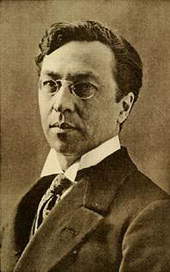 |
| Vasily Kandinsky |
Kandinsky came to these conclusions in 1912, expressing them in his article entitled �?ber die Formfrage, “On the Problem of Form.” In order to arrive at the above, however, there were some decisive steps: one of them was the painter’s attendance, on January 2, 1911, at a concert by the Austrian composer Arnold Schönberg (Vienna, 1874 - Los Angeles, 1951). The painter was deeply moved by the ecstatic music he got to hear at the concert, which was held in Munich, the city where he lived: so much so that he decided to shape his impressions into a painting destined to become one of his most celebrated masterpieces. It is entitled Impression III: Concert, and right from the title we can see how Kandinsky had a propensity to use terms from the lexicon of music for his paintings: impression, improvisation, composition. And this already gives us a very interesting idea of how solid, for Kandinsky, the links between art and music were. The painting, preserved today at the Städtische Galerie im Lenbachhaus in Munich, is dominated by a large black triangle that is sandwiched between a yellow background and a series of colored shapes that are arranged near the bottom edge: the black triangle represents the piano, while the shapes placed on its diagonal, lower left, are the concert-goers. The large yellow mass can probably be interpreted as the sound of the piano investing the audience and igniting them with fervor: it does not seem strange to detect people leaning forward to applaud the musician. A musician who, in our case, is a woman, Etta Werndorff, who played at the concert attended by Kandinsky, and who certainly appears much more evident in the two sketches made on paper for the painting than in the finished work. The sketches, moreover, help us better identify the figures that appear on the far left, and who are supposed to be other musicians who played at the concert. The figure that appears as a white rectangle surmounted by a purple roundel and crossed by a black diagonal line should be soprano Marie Gutheil-Schoder, while the figures around her have been identified as the members of the Rosé Quartet, who played Schoenberg’s string pieces in the Munich concert. Moreover, the two drawings that preceded the work are also crucial for understanding Kandinsky’s creative process: between the first and the second the difference is, in fact, abysmal. If in the first one we could still find a hint of the traditional rules of painting (we see how the concert hall is scaled in perspective), and every element is still easily intuitable, the final result confronts us with a work in which the degree of abstraction is much higher: it even becomes difficult to locate the chandelier clearly recognizable in the first drawing (perhaps, in the painting Kandinsky rendered it with blue marks above the piano).
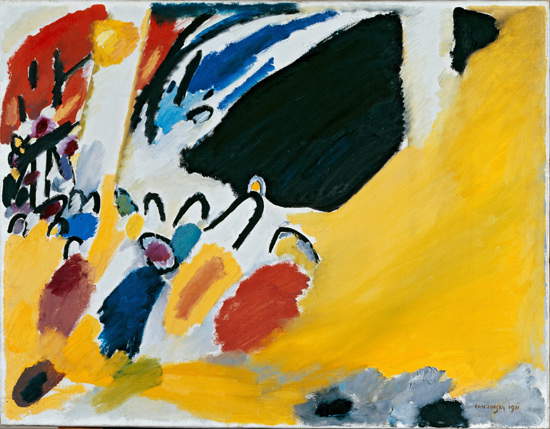 |
| Vasily Kandinsky, Impression III (Concert) (1911; oil on canvas, 77.5 x 100 cm; Munich, Städtische Galerie im Lenbachhaus) |
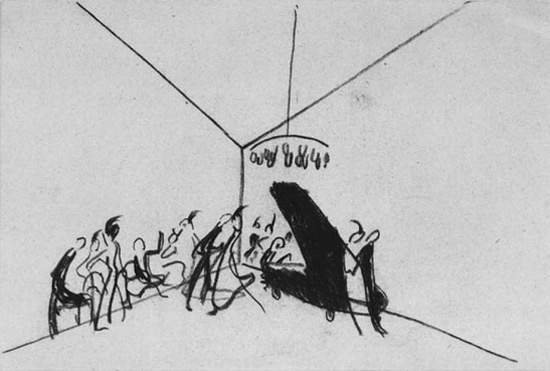 |
| Vasily Kandinsky, First Sketch for Impression III (Concert) (1911; charcoal on paper, 10 x 14.9 cm; Paris, Musée National d’Art Moderne, Centre Pompidou) |
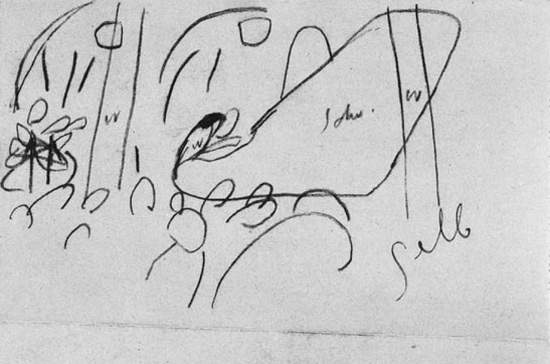 |
| Vasily Kandinsky, Second Sketch for Impression III (Concert) (1911; charcoal on paper, 10 x 14.8 cm; Paris, Musée National d’Art Moderne, Centre Pompidou) |
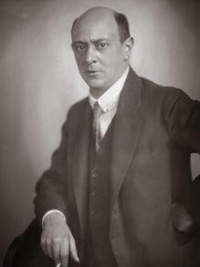 |
| Arnold Schoenberg |
Schoenberg, who moreover dabbled in painting, responded to Kandinsky on January 24 with a statement that provides us with several elements for understanding the meaning of his (and Kandinsky’s) art: “Art belongs to the unconscious! The artist must express himself! And he must express himself directly! He must not express his own taste, education, intelligence, knowledge or skills. He must not, in short, express what he has acquired, but what is innate, what is instinctive. [...] I do not believe that painting must necessarily be objective. On the contrary, I firmly believe in the opposite.” Inspired by Schoenberg’s research, Kandinsky came to elaborate an art in which the desire to express “dissonance” is embodied in bright tones, juxtaposed masses of colors, abstract forms that develop and chase each other as in a musical composition, absence of drawing and rigid patterns. Kandinsky was the first artist to liberate art from reality: with him, for the first time in the history of art, the work was no longer intended to represent elements drawn from the world around us. It was the beginning ofabstract art. And although Kandinsky’s (and all of art history’s) first abstract work is identified by critics as his first abstract watercolor of 1910 (thus dating from a year before his meeting with Schoenberg), a further turning point is offered by Figure with Circle, from 1911: the first abstract oil painting. The artist deliberately chose the title “Figure with Circle” (in German, Bild mit Kreis), and in addition he himself acknowledged that that was the first abstract artwork in history-a recognition of considerable importance. In 1935, writing to the art dealer Jsrael Ber Neumann, he described the painting as follows, “It is a very large, almost square picture, with very vivid shapes, and a large circular shape in the upper right corner.” Kandinsky’s work is a triumph of colors that take on the freest and most varied forms, which with all evidence follow a harmonious rhythm dictated by the artist’s feeling. There are those who see a face in the painting, complete with eyes and mouth, those who see an animal, those who will surely see something else in it: however, any attempt to trace the painting back to an element of reality can only be in vain. What matters is that the colors are for Kandinsky like musical notes, which the artist arranges on the score to move the soul of those in front of the work.
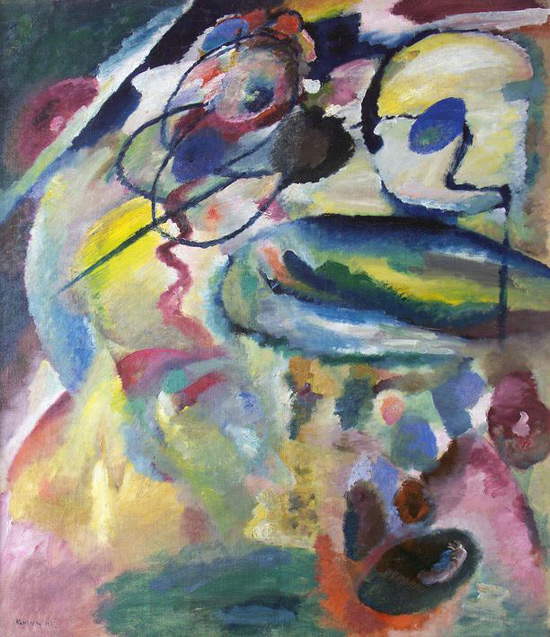 |
| Vasily Kandinsky, Figure with Circle (1911; oil on canvas, 100 x 150 cm; Tbilisi, National Museum of Georgia) |
Initially, the painter was not satisfied with this work: he probably felt that he had not expressed well what he intended to express (although he would later change his judgment). It was, however, a sign that his research was far from having found its fulfillment. Not least because, for Vasily Kandinsky, art should be a response to the world in which one lives. For him, in fact, the need to find an art that disengaged itself from reality was a symptom that the artist was living in an age of decadence: in the words of a great art critic, Mario De Micheli, “it appears evident that for Kandinsky the new conception of art is a way of saving oneself out of history.” The Russian painter was convinced that an artist living in a happy world produces realistic art, and subjective art is instead the prerogative of an artist living in an age of unhappiness. “The more horrible the world becomes (like today’s), the more abstract our art becomes, while a happy world produces realistic art”: this is what Kandinsky wrote in his diary in 1914. That was the year World War I began: the paths of the Russian painter and Arnold Schoenberg, who until then remained linked by a deep professional friendship, were forced to part. The correspondence then resumed in 1922, but the following year the unfounded rumor that Kandinsky was anti-Semitic reached Schoenberg’s ear, who was Jewish. The painter could not accept his relationship with the composer being undermined by backbiting, so the two clarified, but the correspondence continued on rather cool and detached tones. Although without the regularity and intensity of the first phase, the two continued to write to each other until 1936. Today we recognize, in this epistolary exchange between two of the most influential figures of the 20th century in their respective fields, one of the highlights of the art of the last century: who knows what would have happened if on January 2, 1911, Kandinsky had not decided to go together with his friends to the Munich concert. Perhaps, art history would have taken a different turn?
Reference bibliography
Warning: the translation into English of the original Italian article was created using automatic tools. We undertake to review all articles, but we do not guarantee the total absence of inaccuracies in the translation due to the program. You can find the original by clicking on the ITA button. If you find any mistake,please contact us.